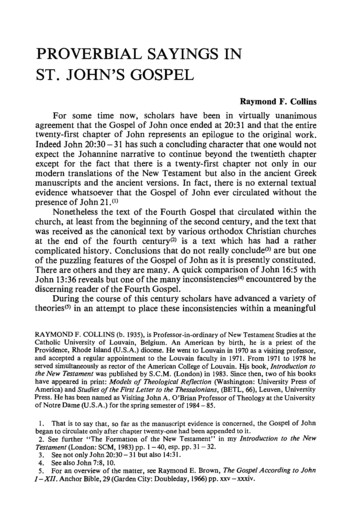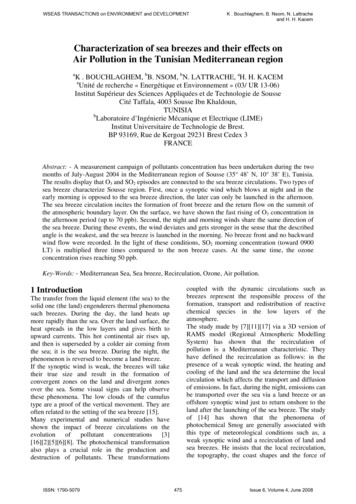
Transcription
This discussion paper is/has been under review for the journal Geoscientific ModelDevelopment (GMD). Please refer to the corresponding final paper in GMD if available.Discussion PaperGeosci. Model Dev. Discuss., 8, 3403–3441, oi:10.5194/gmdd-8-3403-2015 Author(s) 2015. CC Attribution 3.0 License. 11121C. Rousset , M. Vancoppenolle , G. Madec , T. Fichefet , S. Flavoni ,234111A. Barthélemy , R. Benshila , J. Chanut , C. Levy , S. Masson , and F. VivierDiscussion PaperThe Louvain-la-Neuve sea ice modelLIM3.5: global and regional capabilitiesGMDD8, 3403–3441, 2015TheLouvain-la-Neuve seaice model LIM3.5:global and regionalcapabilitiesC. Rousset et al.Title Page 1Received: 24 March 2015 – Accepted: 10 April 2015 – Published: 29 April 2015 3403Discussion PaperPublished by Copernicus Publications on behalf of the European Geosciences Union. Correspondence to: C. Rousset (clement.rousset@locean-ipsl.upmc.fr)Discussion PaperSorbonne Universités (UPMC Paris 6), LOCEAN-IPSL, CNRS/IRD/MNHN, Paris, FranceCentre Georges Lemaître for Earth and Climate Research, Université catholique de Louvain,Louvain-la-Neuve, Belgium3CNRS/LEGOS, Toulouse, France4Mercator Ocean, Ramonville Saint-Agne, blesFiguresJIJIBackCloseFull Screen / EscPrinter-friendly VersionInteractive Discussion
5 3404Discussion Paper25IntroductionSea ice covers 3–6 % of the Earth’s surface and is characterized by ample seasonalvariations, making it one of the most influential geophysical features in the Earth system(Comiso, 2010). Mostly because of its high albedo and thermal insulation power, seaice affects the weather and more generally climate (e.g., Budkyko, 1969; Vihma, 2014).The seasonal cycle of ice growth and melt strongly impacts the vertical upper ocean8, 3403–3441, 2015TheLouvain-la-Neuve seaice model LIM3.5:global and regionalcapabilitiesC. Rousset et al.Title PageDiscussion Paper1GMDD 20Discussion Paper15 10We present the new 3.5 version of the Louvain-la-Neuve sea ice model (LIM) integrated in NEMO 3.6. The main novelty is the improvement of model robustness andversatility for a wide range of applications, from global to regional scales. Several modifications to the code were required. First, the time stepping scheme of the model waschanged from parallel to sequential (ice dynamics first, then thermodynamics). Sucha scheme enables to diagnose the different physical processes responsible for exchanges through the air–ice–ocean interfaces, as well as the online inspection of mass,heat and salt conservation properties of the code. In the course of these developments,several minor conservation leaks were found and fixed, so that LIM3.5 is exactly conservative. Second, lateral boundary conditions for regional ice-covered configurationshave been implemented. To illustrate the new capabilities, two simulations are performed. One is a global simulation at a nominal 2 resolution forced by atmosphericclimatologies and is found reasonably realistic although no specific tuning was done.The other is a regional simulation at 2 km resolution around the Svalbard Archipelagoin the Arctic Ocean, with prescribed conditions at the four boundaries including tides.The simulation is able to resolve small-scale features and transient events such as theopening and closing of coastal polynyas. The ice mass budgets for both simulationsare illustrated and mostly differ by the strength of ice formation in open water. LIM3.5now forms a solid base for future scientific studies and model developments.Discussion ncesTablesFiguresJIJIBackCloseFull Screen / EscPrinter-friendly VersionInteractive Discussion
3405 8, 3403–3441, 2015TheLouvain-la-Neuve seaice model LIM3.5:global and regionalcapabilitiesC. Rousset et al.Title PageDiscussion Paper Discussion Paper25GMDD 20Discussion Paper15 10Discussion Paper5density structure and is a key driver of the ocean circulation at global scale throughdense water formation (Aagaard and Carmack, 1989; Goosse and Fichefet, 1999).Sea ice also influences marine primary productivity and carbon export to depth (e.g.Thomas and Dieckmann, 2010; Vancoppenolle et al., 2013), and constitutes a habitatfor Arctic and Antarctic fauna, including specific microbial, birds and mammal species(Croxall et al., 2002; Atkinson et al., 2004).Given the difficulty to observe polar regions, numerical modelling is essential to understand sea ice processes and their influence on the other components of the Earthsystem. Indeed, a sea ice component is presently included in virtually all ocean andEarth modelling systems (e.g. Flato et al., 2013; Danabasoglu et al., 2014). The contemporary use of sea ice models encompasses a wide range of applications, fromlarge-scale climate to small-scale process studies and operational forecasts. The physical processes at stake need to be well resolved at the appropriate spatial and temporalscales. Hence, sea ice models must be both physically reliable and versatile in a widerange of scales, and at a reasonable computational cost.In order to match these constraints, technical changes were made to the Louvainla-Neuve sea ice model (LIM3, Vancoppenolle et al., 2009b), leading to the version3.5 which is presented here. LIM is the reference sea ice model in the NEMO systemalong with the interface for CICE (Hunke et al., 2013), and will be used in the forthcoming IPSL Earth System model (Dufresne et al., 2013), EC-Earth (Hazeleger et al.,2010), and CMCC-CM (Scoccimarro et al., 2011) CMIP6 models. For climate simulations, the exact conservation of mass, heat and salt is essential. This sanity checkcould not be diagnosed and was not fulfilled in LIM3 until now, mostly due to the timestepping scheme. Therefore, the latter was reshaped to allow the control of the exchanges at the air–ice–ocean interfaces. Several minor conservation leaks were foundand corrected. Moreover, the regional capabilities of NEMO with LIM3 were limited.In particular, open boundary conditions for sea ice were not implemented which prevented regional studies in ice-covered areas. LIM3.5 is the first version which allows inand outflows communications through open esTablesFiguresJIJIBackCloseFull Screen / EscPrinter-friendly VersionInteractive Discussion
Discussion Paper 34068, 3403–3441, 2015TheLouvain-la-Neuve seaice model LIM3.5:global and regionalcapabilitiesC. Rousset et al.Title PageDiscussion Paper20GMDD 15LIM was originally a B-grid sea ice model developed by Fichefet and Morales Maqueda(1997) including ice dynamics based on the viscous-plastic (VP) rheology (Hibler,1979), the 3-layer thermodynamic formulation of Semtner (1976), the 2nd-ordermoment-conserving scheme of Prather (1986) and various sea ice physical parameterizations. Some years later LIM became LIM2 as it was rewritten in Fortran 90 andcoupled to OPA, a C-grid, finite difference, hydrostatic, primitive equation ocean generalcirculation model (Madec, 2008). LIM2 was later on integrated into the NEMO system,for the global reference configuration ORCA2-LIM (Timmermann et al., 2005).Recently, LIM was improved towards a better account of sub-grid scale physics, giving birth to LIM3 (Vancoppenolle et al., 2009a, b). New advances reside mainly in theintroduction of an elastic term for rheology (EVP) on a C-grid (Bouillon et al., 2009,2013), multiple ice categories to represent the sub-grid scale ice thickness distribution (Thorndike et al., 1975), and a multi-layer halo-thermodynamic component including brine dynamics and their impact on ice thermal properties and ice–ocean salt exchanges. A brief description of the physics of LIM is given hereafter.Discussion Paper10Model description 2Discussion Paper5This paper is organized as follows. The representation of sea ice physics in LIM isbriefly described in Sect. 2. Sections 3 and 4 are dedicated to the new capabilities ofLIM, which are illustrated in the framework of NEMO in its most recent version 3.6. We show how the model behaves in two configurations: (i) a large-scale global 2resolution configuration and (ii) a regional 2 km resolution configuration around theSvalbard Archipelago, a region well suited to study various sea ice regimes as wellas transient events such as polynyas. Conclusions and perspectives are presented inSect. iguresJIJIBackCloseFull Screen / EscPrinter-friendly VersionInteractive Discussion
Conservation of area and ice thickness categoriesTo account for unresolved sub-grid scale variations in ice thickness (h), the state ofsea ice is given by a thickness distribution function g(x, y, h, t) (Thorndike et al., 1975),defined as the limit5(1) g · (gu) ψ (f g) t h(2)Discussion Paperwhere dA is the areal fraction of a small control surface with thickness between h andh dh.Invoking continuity, the conservation of area can be written as: dA,dh 0 dhg limDiscussion Paper2.1GMDD8, 3403–3441, 2015TheLouvain-la-Neuve seaice model LIM3.5:global and regionalcapabilitiesC. Rousset et al.Title Page3407 Discussion Paper20Discussion Paper15The terms on the right-hand side are: (i) advection by the horizontal velocity u, (ii)mechanical redistribution (ψ) (i.e. ridging/rafting), and (iii) thermodynamical processes,with f dh/dt the net ice growth/melt rate. In practice, the thickness distribution isdiscretized over (typically 5) thickness categories (Bitz et al., 2001; Lipscomb, 2001),each characterized by a specific areal fraction (referred to as concentration). The icethickness in each category is free to evolve between fixed boundaries.The state of the ice is defined by a series of state variables X (x, y, h, t, z), namelyice concentration, ice volume per unit area, ice internal energy, ice salt content, snowvolume per unit area and snow internal energy. Ice internal energy is the only statevariable which also depends on the vertical depth in the ice (z). Ice salt content doesnot depend on z since implicit vertical salinity profiles are assumed. Following the discretization of thickness space, state variables are characterized by specific values ineach category. In addition, in order to resolve the vertical profiles of internal energy,each category is further vertically divided into one layer of snow and several ice layersof equal thicknesses. iguresJIJIBackCloseFull Screen / EscPrinter-friendly VersionInteractive Discussion
X · (X u) D 2 X ΨX ΘX t(3)where · (X u) is the horizontal advection, D 2 X is the horizontal diffusion, ΨX is theridging/rafting and ΘX is the halo-thermodynamics.2.2DynamicsMomentum equationThe ice velocity is considered the same for all categories and is determined from thetwo-dimensional momentum equation:mP P He C(1 A)(5) 3408Discussion Paperwhere m is the ice mass per unit area, A is concentration, τa and τw are the air–iceand ocean–ice stresses, mf k u is the Coriolis force, mg η is the pressure forcedue to horizontal sea surface tilt and · σ refers to internal forces arising in responseto deformation. Momentum advection is at least one order of magnitude smaller thanacceleration and is neglected (Thorndike, 1986). The external stress terms are multiplied by concentration to satisfy free drift at low concentration (Connolley et al., 2004).The stress tensor σ is computed using the C-grid elastic-viscous-plastic (EVP) formulation of Bouillon et al. (2009, 2013). EVP (Hunke and Dukowicz, 1997) regularizes theoriginal viscous-plastic (VP) approach (Hibler, 1979). VP assumes a viscous ice flow(stress proportional to deformation) at very small deformations, and a plastic ice flow(stress independent of deformation) above a plastic failure threshold. This thresholdlies on a so-called charge which depends on the ice strength determined by defaultfrom Hibler (1979): 208, 3403–3441, 2015TheLouvain-la-Neuve seaice model LIM3.5:global and regionalcapabilitiesC. Rousset et al.Title PageDiscussion Paper15(4)GMDD 10 u A (τa τw ) mf k u mg η · σ tDiscussion Paper2.2.1 5Discussion PaperIn practice, sea ice state variables follow an equation of the esFiguresJIJIBackCloseFull Screen / EscPrinter-friendly VersionInteractive Discussion
Discussion Paper5where P and C are empirical positive parameters. H is the ice volume per grid cellarea. Other strength formulations are available in the code (e.g. Rothrock, 1975; Lipscomb et al., 2007), see Vancoppenolle et al. (2012) for details. The EVP method improves accuracy at short time scales, introducing artificial damped elastic waves anda time-dependence to the stress tensor. This method enables an explicit resolution ofthe momentum equation with a reasonable number of sub-time steps ( 100). 10Ridging and rafting 3409Discussion PaperThe dissipation of energy associated with plastic failure under convergence and shearis accomplished by rafting (overriding of two ice plates) and ridging (breaking of anice plate and subsequent piling of the broken ice blocks into pressure ridges). Thin icepreferentially rafts whereas thick ice preferentially ridges (Tuhkuri and Lensu, 2002). InLIM3.5, the amount of ice that rafts/ridges depends on the strain rate tensor invariants(shear and divergence) as in Flato and Hibler (1995), while the ice categories involvedare determined by a participation function favoring thin ice (Lipscomb et al., 2007). The00thickness of ice being deformed h determines whether ice rafts (h 0.75 m) or ridges00(h 0.75 m), following Haapala (2000). The deformed ice thickness is 2h after rafting,and is distributed between 2h0 and 2 H h0 after ridging, where H 100 m (Hibler,1980). Newly ridged ice is highly porous, effectively trapping seawater. To represent 252.2.3TheLouvain-la-Neuve seaice model LIM3.5:global and regionalcapabilitiesC. Rousset et al.Title PageDiscussion Paper20The sea ice state variables are transported horizontally using the second-ordermoment-conserving scheme of Prather (1986). This scheme is weakly diffusive andpreserves positivity of the transported ice fields. The added horizontal diffusion mustbe viewed as a numerical artefact to avoid non-linearities arising from the couplingbetween ice dynamics and transport. Horizontal diffusion is solved using a Crank–Nicholson scheme, with a prescribed diffusivity within the ice pack which drops to zeroat the ice edge.8, 3403–3441, 2015 15Horizontal transport and diffusionDiscussion encesTablesFiguresJIJIBackCloseFull Screen / EscPrinter-friendly VersionInteractive Discussion
5Halo-thermodynamics2.3.1EnergyDiscussion PaperThermodynamics refer to the processes locally affecting the ice mass and energy, andinvolving energy transfers through the air–ice–ocean interfaces. Halodynamics refersto the processes impacting sea ice salinity. In the code, both processes are assumedpurely vertical and their computations are repeated for each ice category. Therefore,the reference to ice categories is implicit in this section. 102.3Discussion Paperthis process, mass, salt and heat are extracted from the ocean into a prescribed volumefraction (30 %) of newly ridged ice (Leppäranta et al., 1995). Consequently, simulatednew ridges have high temperature and salinity as observed (Høyland, 2002). A fractionof snow (usually 50 %) falls into the ocean during deformation.GMDD8, 3403–3441, 2015TheLouvain-la-Neuve seaice model LIM3.5:global and regionalcapabilitiesC. Rousset et al.Title PageDiscussion Paper 3410 20with z the vertical (layer) coordinate, ρ the snow/ice density (assumed constant), Ethe snow/ice internal energy per unit mass (Schmidt et al., 2004), S the salinity, κthe thermal conductivity (Pringle et al., 2007) and R the internal solar heating rate.The effect of brine inclusions are represented through the S and T dependency of Eand κ (e.g. Untersteiner, 1964; Bitz and Lipscomb, 1999). The surface energy balance(flux condition) and a bottom ice temperature at the freezing point provide boundaryconditions at the top and bottom interfaces, respectively. Equation (6) is non-linear andis solved iteratively. Change in ice salinity is assumed to conserve energy, hence anysalt loss implies a small temperature increase.Discussion Paper15 The change in the vertical temperature profile T (z, t) of the snow–ice system derivesfrom the heat diffusion equation: E (S, T ) Tρ κ(S, T ) R(6) t z guresJIJIBackCloseFull Screen / EscPrinter-friendly VersionInteractive Discussion
QFm . E 125 E (J kg ) is the energy per unit mass required for the phase transition. For new iceformation in open water, the new ice thickness must be prescribed (usually 10 cm) andthe fractional area is derived from Eq. (7). For surface melting, Q is different from zeroonly if the surface temperature is at the freezing point. 3411Discussion Paper(7)8, 3403–3441, 2015TheLouvain-la-Neuve seaice model LIM3.5:global and regionalcapabilitiesC. Rousset et al.Title PageDiscussion Paper20The ice mass increases by (i) new ice formation in open water, (ii) congelation at theice base, (iii) snow–ice formation at the ice surface and (iv) entrapment and freezingof seawater into newly formed ridges. And it decreases by melting at both (v) the surface and (vi) the base. The snow mass increases by snowfall and reduces by surfacemelting, sublimation, snow–ice formation and snow loss during ridging/rafting.Freezing and melting (i, ii, v, vi) depend on the appropriate interfacial net energy flux 2(open water–atmosphere, ice–atmosphere or ice–ocean) Q (W m ) such that them 2 1ocean-to-ice mass flux F (kg m s ) is written as:GMDD 15MassDiscussion Paper2.3.2 10Discussion Paper5The solar energy is apportioned as follows. The net solar flux penetrating throughthe snow–ice system is (1 α)Fsol , where α is the surface albedo and Fsol is the incoming solar radiation flux. Only a prescribed fraction i of the net solar flux penetrates below the surface and attenuates exponentially, whereas the rest is absorbed bythe surface where it increases the surface temperature. The radiation term in Eq. (6)derives from the absorption of the penetrating solar radiation flux R / z[i0 (1 α)Fsw exp( z/L)], where L 1 m is the length of attenuation. At this stage no shortwave radiation penetration is allowed when snow is present (i0 0). The solar radiation flux penetrating down to the ice base is sent to the ocean. The surface albedo isa function of the ice surface temperature, ice thickness, snow depth and cloudiness(Shine and Henderson-Sellers, lesFiguresJIJIBackCloseFull Screen / EscPrinter-friendly VersionInteractive Discussion
15Salt20j The first term on the right-hand side is the salt uptake summed over the three ice growthprocesses (ii, iii and iv), each characterized by a growth rate hj / t and a coefficientνj that determines the fraction of trapped oceanic salinity Sw . For basal freezing, νj isa function of growth rate (Cox and Weeks, 1988). For snow–ice formation, it is a function of snow and ice densities. For ridging, it depends on ridge porosity. The second3412Discussion Paperj The salinity of the new ice formed in open water is determined from ice thickness, usingthe empirical thickness–salinity relationship of Kovacs (1996). The vertically averagedice salinity S (in ‰) evolves in time following Vancoppenolle et al. (2009a, b) as: XXSSνS hS Sj j w j Ij (8) th tTj8, 3403–3441, 2015TheLouvain-la-Neuve seaice model LIM3.5:global and regionalcapabilitiesC. Rousset et al.Title PageDiscussion Paper2.3.3GMDD Every ice–ocean mass exchange involves corresponding energy and salt exchanges(Schmidt et al., 2004). For instance, seawater freezing involves a change in energy E Ei (S, T ) Ew (Tw ), where Ei is the internal energy of the frozen ice at its new temperature and salinity and Ew is the internal energy of the source seawater at its original temperature. To ensure heat conservation in the ice–ocean system, the heat fluxmmQ Ew (Tw )F is extracted from the ocean. Conversely, when ice melts the internalenergy of melt water is sent to the ocean. Salt exchanges are detailed hereafter.Discussion Paper10 h t F m (ρi ρs )Discussion Paper5Snow-ice formation requires negative freeboard, which occurs if the snow load islarge enough for the snow–ice interface to lie below sea level (Fichefet and MoralesMaqueda, 1997). Seawater is assumed to flood the snow below sea level and freezethere, conserving heat and salt during the process. The associated ocean-to-ice massflux FiguresJIJIBackCloseFull Screen / EscPrinter-friendly VersionInteractive Discussion
Discussion Paper 3413 Ice growth or melt in a given category involves a transfer of ice to neighbor categories,which is formally analogous to a transport in thickness space with a velocity equalto the net growth rate dh/dt. This transport in thickness space is solved using thesemi-lagrangian linear remapping scheme of Lispcomb (2001). This scheme is weaklydiffusive, converges with a few categories and its computational cost is minimal, animportant property since transport operates over each ice category. Transport in thickness space is applied to all other state variables, as well.8, 3403–3441, 2015TheLouvain-la-Neuve seaice model LIM3.5:global and regionalcapabilitiesC. Rousset et al.Title PageDiscussion Paper20Transport in thickness spaceGMDD 2.3.4Discussion Paper15 10Discussion Paper5term on the right-hand side is the salt loss summed over the two parameterized brinedrainage processes (gravity drainage and flushing; see Notz and Worster, 2009). Ij is1 if the drainage process is active and 0 if it is not. Gravity drainage occurs if ice isgrowing at the base; flushing occurs if the snow/ice is melting at the surface. Sj (5 ‰for gravity drainage; 2 ‰ for flushing) is the restoring salinity for each drainage process and Tj is the corresponding time scale (20 days for gravity drainage, 10 days forflushing).The shape of the vertical salinity profile depends on S, so that ice with S 4.5 ‰has a vertically constant profile. By contrast, ice fresher than this threshold has a linearprofile with a lower salinity near the surface. This difference is important to properlyrepresent the impact of brine on thermal properties (Vancoppenolle et al., 2005). Iceformation retrieves salt from the ocean but the conjunction with water mass loss makesthe ocean surface saltier. Conversely, ice melting releases salt but makes the oceanfresher. Brine drainage is not associated with an exchange of water mass, so the saltrelease directly increases ocean TablesFiguresJIJIBackCloseFull Screen / EscPrinter-friendly VersionInteractive Discussion
3.15 3414Discussion Paper25Change in the heat diffusion algorithmThe conservation of mass, salt and heat was then carefully inspected, leading to several small corrections. In particular, the scheme used to solve the heat diffusion equation (Eq. 6), a space-centered implicit backward-Euler one (Bitz and Lipscomb, 1999),does not strictly conserve heat. The scheme is the same as in CICE, for which the problem was already reported but was not resolved to our knowledge (Hunke et al., 2013).8, 3403–3441, 2015TheLouvain-la-Neuve seaice model LIM3.5:global and regionalcapabilitiesC. Rousset et al.Title PageDiscussion Paper3.2GMDD 20Mass, heat and salt should be perfectly conserved over sufficiently long time scales inan ice–ocean modelling system, especially for climate studies. Moreover, for analysispurpose, the contributions from the different processes should be identified. This hasmotivated a change in the time stepping scheme as well as in the algorithm used tosolve the heat diffusion equation.The dynamical and thermodynamical time evolutions of the state variables were previously calculated in parallel, starting from the same initial state (Fig. 1a). Both tendencies were then combined to calculate the new state variables. This method, numerically stable and matching NEMO’s philosophy required however a final correction stepto impose that ice losses (by melting and/or divergence) did not exceed the ice initiallyavailable. This correction step could be as important as the physical processes in somecases, and could not be attributed to a specific process.The modified temporal scheme is sequential (as for LIM2 and CICE), removing theneed for a correction step. The ice state variables are first modified by dynamical processes, then by halo-thermodynamics (Fig. 1b). The scheme allows consistent diagnostics of the processes contributing to the atmosphere–ice–ocean exchanges withoutaltering the general model behavior (not shown). This is illustrated in the next section in a global ice–ocean simulation at 2 resolution ORCA2-LIM3.Discussion Paper15Change in the time stepping scheme 10Control of the mass, salt and heat budgetsDiscussion lesFiguresJIJIBackCloseFull Screen / EscPrinter-friendly VersionInteractive Discussion
3.3.1Other changesCategory boundariesDiscussion Paper3.3 10Discussion Paper5Because Eq. (6) is non-linear (E and κ depend on S and T ) and both surface and internal layer temperatures evolve at the same time, the numerical procedure has to be iter 5 ative until temperature change is less than 10 C or after 50 iterations. The scheme 2does not strictly converge and leads to small errors on heat flux of 0.005 W m , av eraged over the ice pack for a global 2 resolution simulation, with maxima reachingin some rare cases O(10 W m 2 ). These errors are similar to those reported in CICEuser guide (0.01 W m 2 , Hunke et al., 2013). Therefore, to ensure strict conservation,either heat fluxes or ice temperature must be further adjusted at the end of iteration. Wechose to recalculate the turbulent ocean-to-ice heat flux, subject to large uncertaintyand directly involved in the basal energy budget.GMDD8, 3403–3441, 2015TheLouvain-la-Neuve seaice model LIM3.5:global and regionalcapabilitiesC. Rousset et al.Title Page Discussion Paper 3415Discussion Paper20 15The original discretization of the thickness category boundaries follows the hyperbolictangent formulation from CICE (Hunke et al., 2013). The formulation proved to be suitable to simulate the Arctic ice pack with only five ice categories, but is hardly adaptableto different ice conditions. For instance, thin ice can only be finely discretized by augmenting the number of ice categories, and de facto increasing computational cost. Multiple simulations, in particular for regional configurations, call for more flexibility withoutadditional cpu consumption. Therefore, a new discretization was implemented that canadjust the expected mean ice thickness h over the domain. Category boundaries lie αbetween 0 and 3h and are determined using a fitting function proportional to (1 h) ,where α 0.05. For h 2 m, the new formulation is very similar to the original one. Forh 1 m, boundaries tighten within 3 m, providing more resolution for thin ice (Fig. FiguresJIJIBackCloseFull Screen / EscPrinter-friendly VersionInteractive Discussion
53.4Global ice–ocean simulation: ORCA2-LIM3Discussion PaperLIM3 has been completely interfaced with XIOS (XML Input Output Server: http://forge.ipsl.jussieu.fr/ioserver/), a new and innovative library developed at Institut Pierre-etSimon Laplace (IPSL) and dedicated to climate modelling data output. XIOS combinesflexibility and performance. It considerably simplifies output definition and managementby outsourcing output description in an external XML file. In addition, the interface offers numerous possibilities of variables manipulation such as complex temporal operations and computations involving several variables. XIOS also achieves excellentperformance to output data on massively parallel supercomputers by using several“server” processes exclusively dedicated to data writing. File system writing is totallyoverlapped by computation. 10In and outputsDiscussion Paper3.3.2GMDD8, 3403–3441, 2015TheLouvain-la-Neuve seaice model LIM3.5:global and regionalcapabilitiesC. Rousset et al.Title Page 3416Discussion Paper25 20The simulation presented here uses the most recent 3.6 version of NEMO. It comprisesthe ocean general circulation model OPA version 3.6 (Madec, 2008) and LIM (Vancoppenolle et al., 2009b) in its 3.5 version presented above, running on the same tripolar 2 resolution grid (ORCA2). More details can be found in Mignot et al. (2013). The atmospheric state is imposed using the CORE normal year forcing set proposed by Largeand Yeager (2009). This forcing was developed to inter-compare ice–ocean models(e.g. Griffies et al., 2009). It is based on a combination of NCEP/NCAR reanalyzes (forwind, temperature and humidity) and various satellite products (for radiation), has a 2 resolution and near zero global mean heat and freshwater fluxes. The so-called normal year dataset superimposes the 1995 synoptic variability on the mean 1984–2000seasonal cycle. The simulation lasts 100 years, much longer than needed for sea iceto reach equilibrium. Most diagnostics presented hereafter are seasonal averages overthe last 10 years of the simulation. The computational cost of such a simulation is aboutDiscussion Paper15Experimental setup and observation datasets esFiguresJIJIBackCloseFull Screen / EscPrinter-friendly VersionInteractive Discussion
Discussion Paper258, 3403–3441, 2015TheLouvain-la-Neuve seaice model LIM3.5:global
The ice velocity is considered the same for all categories and is determined from the two-dimensional momentum equation: m @u @t A( a w) mfk u mgr r (4) 10 where mis the ice mass per unit area, Ais concentration, a and w are the air-ice and ocean-ice stresses, mfk u is the Coriolis force, mgr is the pressure force










